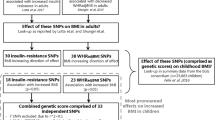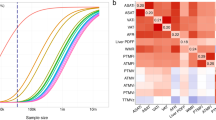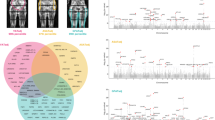Abstract
Background:
Genome-wide association studies (GWASs) identified single-nucleotide polymorphisms (SNPs) involved in adult fat distribution. Whether these SNPs also affect abdominal and organ-specific fat accumulation in children is unknown.
Methods:
In a population-based prospective cohort study among 1995 children (median age: 9.8 years, 95% range 9.4–10.8), we tested the associations of six genetic risk scores based on previously identified SNPs for childhood body mass index (BMI), adult BMI, liver fat, waist–hip ratio, pericardial fat mass, visceral and subcutaneous adipose tissue ratio (VAT/SAT ratio) and four individual SAT- and VAT-associated SNPs for association with SAT (N=1746), VAT (N=1742), VAT/SAT ratio (N=1738), liver fat fraction (N=1950) and pericardial fat mass (N=1803) measured by magnetic resonance imaging.
Results:
Per additional risk allele in the childhood BMI genetic risk score, SAT increased 0.020 s.d. scores (SDS) (95% confidence interval (CI): 0.009 to 0.031, P-value: 3.28 × 10−4) and VAT increased 0.021 SDS (95% CI: 0.009 to 0.032, P-value: 4.68 × 10−4). The adult BMI risk score was positively associated with SAT (0.022 SDS increase, CI: 0.015 to 0.029, P-value: 1.33 × 10−9) and VAT (0.017 SDS increase, CI: 0.010 to 0.025, P-value: 7.00 × 10−6) and negatively with VAT/SAT ratio (−0.012 SDS decrease, CI: −0.019 to −0.006, P-value: 2.88 × 10−4). The liver fat risk score was associated with liver fat fraction (0.121 SDS, CI: 0.086 to 0.157, P-value: 2.65 × 10−11). Rs7185735 (SAT) was associated with SAT (0.151 SDS, CI: 0.087 to 0.214, P-value: 3.00 × 10−6) and VAT/SAT ratio (−0.126 SDS, CI: −0.186 to −0.065, P-value: 4.70 × 10−5). After stratification by sex the associations of the adult BMI risk score with SAT and VAT and of the liver fat risk score with liver fat fraction remained in both sexes. Associations of the childhood BMI risk score with SAT, and the adult BMI risk score with VAT/SAT ratio, were present among boys only, whereas the association of the pericardial fat risk score with pericardial fat was present among girls only.
Conclusion:
Genetic variants associated with BMI, body fat distribution, liver and pericardial fat already affect body fat distribution in childhood.
This is a preview of subscription content, access via your institution
Access options
Subscribe to this journal
Receive 12 print issues and online access
$259.00 per year
only $21.58 per issue
Buy this article
- Purchase on Springer Link
- Instant access to full article PDF
Prices may be subject to local taxes which are calculated during checkout

Similar content being viewed by others

References
World Health Organisation. Obesity and Overweight. Fact sheet No 311. Available from http://www.who.int/mediacentre/factsheets/fs311/en/ (accessed January 2017).
Reilly J, Methven E, McDowell Z, Hacking B, Alexander D, Stewart L et al. Health consequences of obesity. Arch Dis Child 2003; 88: 748–752.
Baker J, Olsen L, Sorensen T . Childhood body-mass index and the risk of coronary heart disease in adulthood. N Engl J Med 2007; 357: 2329–2337.
Lewis C, McTigue K, Burke L, Poirier P, Eckel R, Howard B et al. Mortality, health outcomes, and body mass index in the overweight range: a science advisory from the American Heart Association. Circulation 2009; 119: 3263–3271.
Tchernof A, Després J . Pathophysiology of human visceral obesity: an update. Physiol Rev 2013; 2013: 1.
Bays H, González-Campoy J, Bray G, Kitabchi A, Bergman D, Schorr A et al. Pathogenic potential of adipose tissue and metabolic consequences of adipocyte hypertrophy and increased visceral adiposity. Expert Rev Cardiovasc Ther 2008; 6: 343–368.
Després J, Lemieux I, Bergeron J, Pibarot P, Mathieu P, Larose E et al. Abdominal obesity and the metabolic syndrome: contribution to global cardiometabolic risk. Arterioscler Thromb Vasc Biol 2008; 28: 1039–1049.
Tang L, Zhang F, Tong N . The association of visceral adipose tissue and subcutaneous adipose tissue with metabolic risk factors in a large population of Chinese adults. Clin Endocrinol 2016; 85: 46–53.
Hubers M, Geisler C, Plachta-Danielzik S, Muller MJ . Association between individual fat depots and cardio-metabolic traits in normal- and overweight children, adolescents and adults. Nutr Diabetes 2017; 7: e267.
Goodwin K, Syme C, Abrahamowicz M, Leonard GT, Richer L, Perron M et al. Routine clinical measures of adiposity as predictors of visceral fat in adolescence: a population-based magnetic resonance imaging study. PLoS ONE 2013; 8: e79896.
Fox C, Liu Y, White C, Feitosa M, Smith A, Heard-Costa N et al. Genome-wide association for abdominal subcutaneous and visceral adipose reveals a novel locus for visceral fat in women. PLoS Genet 2012; 8: e1002695.
Sacks H, Fain J . Human epicardial adipose tissue: a review. Am Heart J 2007; 153: 907–917.
Liu J, Fox C, Hickson D, Bidulescu A, Carr J, Taylor H . Fatty liver, abdominal visceral fat, and cardiometabolic risk factors: the Jackson Heart Study. Arterioscler Thromb Vasc Biol 2011; 31: 2715–2722.
Rosito G, Massaro J, Hoffmann U, Ruberg F, Mahabadi A, Vasan R et al. Pericardial fat, visceral abdominal fat, cardiovascular disease risk factors, and vascular calcification in a community-based sample: the Framingham Heart Study. Circulation 2008; 117: 605–613.
Speliotes E, Massaro J, Hoffmann U, Vasan R, Meigs J, Sahani D et al. Fatty liver is associated with dyslipidemia and dysglycemia independent of visceral fat: the Framingham Heart Study. Hepatology 2010; 51: 1979–1987.
Pérusse L, Després J, Lemieux S, Rice T, Rao D, Bouchard C . Familial aggregation of abdominal visceral fat level: results from the Quebec family study. Metabolism 1996; 45: 378–382.
Fox C, White C, Lohman K, Heard-Costa N, Cohen P, Zhang Y et al. Genome-wide association of pericardial fat identifies a unique locus for ectopic fat. PLoS Genet 2012; 8: e1002705.
Loomba R, Schork N, Chen C, Bettencourt R, Bhatt A, Ang B et al. Heritability of hepatic fibrosis and steatosis based on a prospective twin study. Gastroenterology 2015; 149: 1784–1793.
Speliotes E, Willer C, Berndt S . Association analyses of 249,796 individuals reveal 18 new loci associated with body mass index. Nat Genet 2010; 42: 937–948.
Locke A, Kahali B, Berndt S, Justice A, Pers T, Day F et al. Genetic studies of body mass index yield new insights for obesity biology. Nature 2015; 518: 197–206.
Felix J, Bradfield J, Monnereau C, van der Valk R, Stergiakouli E, Chesi A et al. Genome-wide association analysis identifies four new susceptibility loci for childhood body mass index. Hum Mol Genet 2016; 25: 389–403.
Monnereau C, Vogelezang S, Kruithof C, Jaddoe V, Felix J . Associations of genetic risk scores based on adult adiposity pathways with childhood growth and adiposity measures. BMC Genet 2016; 17: 120.
Hu H, Nayak K, Goran M . Assessment of abdominal adipose tissue and organ fat content by magnetic resonance imaging. Obes Rev 2011; 12: e504–e515.
Kooijman M, Kruithof C, van Duijn C, Duijts L, Franco O, van IJzendoorn M et al. The Generation R Study: design and cohort update 2017. Eur J Epidemiol 2016; 31: 1243–1264.
Speliotes E, Yerges-Armstrong L, Wu J, Hernaez R, Kim L, Palmer C et al. Genome-wide association analysis identifies variants associated with nonalcoholic fatty liver disease that have distinct effects on metabolic traits. PLoS Genet 2011; 7: e1001324.
Shungin D, Winkler T, Croteau-Chonka D, Ferreira T, Locke A et al. New genetic loci link adipose and insulin biology to body fat distribution. Nature 2015; 518: 187–196.
Chu A, Deng X, Fisher V, Drong A, Zhang Y, Feitosa M et al. Multiethnic genome-wide meta-analysis of ectopic fat depots identifies loci associated with adipocyte development and differentiation. Nat Genet 2016; 49: 125–130.
Kruithof C, Kooijman M, van Duijn C, Franco O, de Jongste J, Klaver C et al. The Generation R Study: Biobank update 2015. Eur J Epidemiol 2014; 29: 911–927.
Li Y, Willer C, Ding J, Scheet P, Abecasis G . MaCH: using sequence and genotype data to estimate haplotypes and unobserved genotypes. Genet Epidemiol 2010; 34: 816–834.
Li Y, Willer C, Sanna S, Abecasis G . Genotype imputation. Annu Rev Genomics Hum Genet 2009; 10: 387–406.
Shuster A, Patlas M, Pinthus J, Mourtzakis M . The clinical importance of visceral adiposity: a critical review of methods for visceral adipose tissue analysis. Br J Radiol 2012; 85: 1–10.
Thomas E, Fitzpatrick J, Malik S, Taylor-Robinson S, Bell J . Whole body fat: content and distribution. Prog Nucl Magn Reson Spectrosc 2013; 73: 56–80.
Mitra S, Fernandez-Del-Valle M, Hill J . The role of MRI in understanding the underlying mechanisms in obesity associated diseases. Biochim Biophys 2016; 1863: 1115–1131.
Reeder S, Cruite I, Hamilton G, Sirlin C . Quantitative assessment of liver fat with magnetic resonance imaging and spectroscopy. J Magn Reson Imaging 2011; 34, spcone.
Gishti O, Gaillard R, Manniesing R, Abrahamse-Berkeveld M, van der Beek E, Heppe D et al. Fetal and infant growth patterns associated with total and abdominal fat distribution in school-age children. J Clin Endocrinol Metab 2014; 99: 2557–2566.
Wells JC, Cole TJ ALSPAC study steam. Adjustment of fat-free mass and fat mass for height in children aged 8 y. Int J Obes Relat Metab Disord 2002; 26: 947–952.
Keijzer-Veen MG, Euser AM, van Montfoort N, Dekker FW, Vandenbroucke JP, Van Houwelingen HC . A regression model with unexplained residuals was preferred in the analysis of the fetal origins of adult diseases hypothesis. J Clin Epidemiol 2005; 58: 1320–1324.
Schleinitz D, Böttcher Y, Blüher M, Kovacs P . The genetics of fat distribution. Diabetologia 2014; 57: 1276–1286.
Taylor R, Grant A, Williams S, Goulding A . Sex differences in regional body fat distribution from pre- to postpuberty. Obesity (Silver Spring) 2010; 18: 1410–1416.
Vogelezang S, Monnereau C, Gaillard R, Renders C, Hofman A, Jaddoe V et al. Adult adiposity susceptibility loci, early growth and general and abdominal fatness in childhood: the Generation R Study. Int J Obes 2015; 39: 1001–1009.
Blüher M . The distinction of metabolically 'healthy' from 'unhealthy' obese individuals. Curr Opin Lipidol 2010; 21: 38–43.
Hardy R, Wills A, Wong A, Elks C, Wareham N, Loos R et al. Life course variations in the associations between FTO and MC4R gene variants and body size. Hum Mol Genet 2010; 19: 545–552.
Fabbrini E, Sullivan S, Klein S . Obesity and nonalcoholic fatty liver disease: biochemical, metabolic, and clinical implications. Hepatology 2010; 51: 679–689.
Frayling T, Ong K . Piecing together the FTO jigsaw. Genome Biol 2011; 12: 104.
Claussnitzer M, Dankel S, Kim K, Quon G, Meuleman W, Haugen C et al. FTO obesity variant circuitry and adipocyte browning in humans. N Engl J Med 2015; 373: 895–907.
Smemo S, Tena JJ, Kim KH, Gamazon ER, Sakabe NJ, Gomez-Marin C et al. Obesity-associated variants within FTO form long-range functional connections with IRX3. Nature 2014; 507: 371–375.
Brambilla P, Bedogni G, Moreno L, Goran M, Gutin B, Fox K et al. Crossvalidation of anthropometry against magnetic resonance imaging for the assessment of visceral and subcutaneous adipose tissue in children. Int J Obes 2006; 30: 23–30.
Acknowledgements
The Generation R Study is conducted by the Erasmus Medical Center in close collaboration with the School of Law and Faculty of Social Sciences of the Erasmus University Rotterdam, the Municipal Health Service Rotterdam area, Rotterdam, the Rotterdam Homecare Foundation, Rotterdam, and the Stichting Trombosedienst and Artsenlaboratorium Rijnmond (STAR), Rotterdam. We gratefully acknowledge the contribution of participating mothers, general practitioners, hospitals, midwives and pharmacies in Rotterdam. The generation and management of GWAS genotype data for the Generation R Study were done at the Genetic Laboratory of the Department of Internal Medicine, Erasmus MC, The Netherlands. We thank Karol Estrada, Dr Tobias A Knoch, Anis Abuseiris, Luc V de Zeeuw and Rob de Graaf for their help in creating GRIMP, BigGRID, MediGRID and Services@MediGRID/D-Grid (funded by the German Bundesministerium fuer Forschung und Technology; Grants 01 AK 803A-H and 01 IG 07015 G) and for access to their grid computing resources. We thank Mila Jhamai, Manoushka Ganesh, Pascal Arp, Marijn Verkerk, Lizbeth Herrera and Marjolein Peters for their help in creating, managing and QC of the GWAS database. Also, we thank Karol Estrada for their support in creation and analysis of imputed data. The general design of Generation R Study is made possible by financial support from the Erasmus Medical Center, Rotterdam, the Erasmus University Rotterdam, the Netherlands Organization for Health Research and Development (ZonMw), the Netherlands Organisation for Scientific Research (NWO), the Ministry of Health, Welfare and Sport and the Ministry of Youth and Families. This research also received funding from the European Union’s Seventh Framework Programme (FP7/2007–2013), project EarlyNutrition under Grant Agreement No. 289346. VWVJ received an additional grant from the Netherlands Organization for Health Research and Development (VIDI 016.136.361) and a Consolidator Grant from the European Research Council (ERC-2014-CoG-648916). JFF has received funding from the European Union’s Horizon 2020 research and innovation programme under Grant Agreement No. 633595 (DynaHEALTH). The study was supported by funding from the European Union’s Horizon 2020 research and innovation programme (733206, LIFECYCLE).
Author information
Authors and Affiliations
Corresponding author
Ethics declarations
Competing interests
The authors declare no conflict of interest.
Additional information
Supplementary Information accompanies this paper on International Journal of Obesity website
Supplementary information
Rights and permissions
About this article
Cite this article
Monnereau, C., Santos, S., van der Lugt, A. et al. Associations of adult genetic risk scores for adiposity with childhood abdominal, liver and pericardial fat assessed by magnetic resonance imaging. Int J Obes 42, 897–904 (2018). https://doi.org/10.1038/ijo.2017.302
Received:
Revised:
Accepted:
Published:
Issue Date:
DOI: https://doi.org/10.1038/ijo.2017.302


